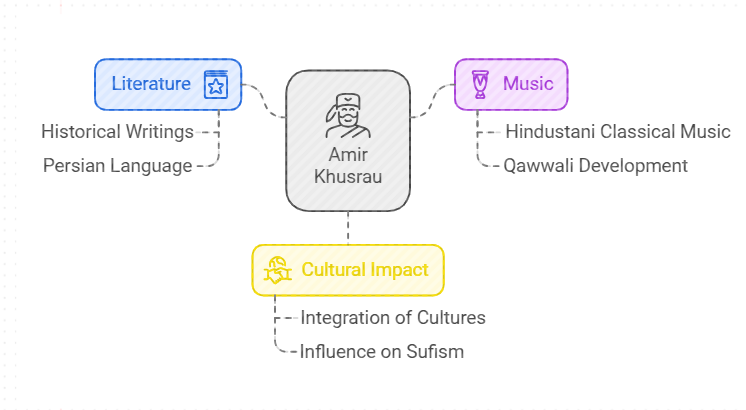Day 17: Amir Khusrau's contributions to literature, music, and culture had a profound impact on the socio-cultural fabric of medieval India. Discuss (150 words)
20 Dec 2024 | GS Paper 1 | Indian Heritage & CultureApproach / Explaination / Answer
Approach
|
Introduction
Amir Khusrau (1253–1325), often referred to as the "Parrot of India" (tuti-e-hind) for his eloquence, was one of the most prominent figures of medieval Indian history.Khusrau's contributions to literature, music, and culture had a profound and lasting impact on the socio-cultural fabric of India.
Body
Contributions to Literature:
- On Social and Political Life: As a courtier, he was deeply involved in the political and cultural affairs of the Delhi Sultanate.
- His historical writings, particularly Khazain-ul-Futuh and Tughlaq Nama, offer valuable insights into the reigns of his contemporaries, providing a glimpse into the complex political landscape of medieval India.
- Language and Style: Khusrau is credited with popularizing Persian as the language of the Indian elite and making it accessible to a broader audience.
- His poetic works like Divan-e-Khusrau not only contributed to the flourishing of Persian literature but also helped in shaping the intellectual landscape of medieval India.
Contributions to Music:
- Innovations in Hindustani Classical Music: He is often regarded as the father of Hindustani classical music due to his groundbreaking fusion of Persian, Turkish, and Indian musical traditions.
- He played a crucial role in developing new ragas like Yaman, Bhairav, and Hamsadhwani, which remain integral to classical music today.
- Khusrau also pioneered the development of Qawwali, a genre of Sufi devotional music.
- He is credited with innovating the tabla and introducing it into classical music.
Cultural Impact:
- Integration of Cultures: Khusrau's works embody the blending of Persian, Indian, and Central Asian traditions, contributing to the rise of a syncretic culture.
- His literature, music, and teachings helped bridge the cultural divide between Hindus and Muslims in India.
- Influence on Sufism: Khusrau’s association with the Chishti Sufi Order, particularly his spiritual relationship with Hazrat Nizamuddin Aulia, led him to integrate Sufism deeply into his literary and musical works.
- His poetry became central to the devotional practices of the Sufi mystics, spreading Sufi ideals of love, peace, and unity across India.
Conclusion
Amir Khusrau’s literary works elevated Persian as a language of culture, his music laid the foundation for Hindustani classical music, and his spiritual teachings contributed significantly to the Sufi movement. Khusrau’s ability to fuse diverse cultural elements created a lasting syncretic tradition that enriched India’s cultural heritage.
